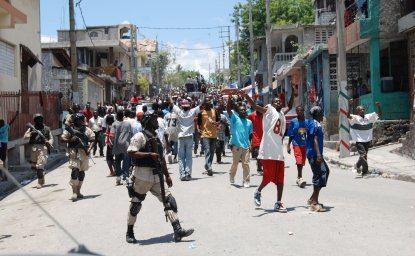314. Now That the Wars Have Ended, Did We Learn Anything?

Ellen Comisso is Professor of Political Science at the University of California-San Diego. She spoke at an EES noon discussion on April 20, 2005. The following is a summary of her presentation. Meeting Report 314.
Yugoslavia's dramatic dissolution provoked an outpouring of scholarly, journalistic and autobiographical commentary throughout the 1990s, and it was only with the end of major bloodshed and the departure of the primary villain(s) from the scene at the start of the new millennium that the Balkans receded from the center of the public eye. Yet now that the dust has settled, it is appropriate to ask whether or not we have learned anything from the events of that decade. In particular, what caused a once-functioning and respected state to disintegrate, and to disintegrate as violently as it did, and are there any inferences we can make about the management of sectarian strife in other multinational polities—including the entities that once made up pre-1990 Yugoslavia?
Most observers of Yugoslavia's wars offer complex accounts, and taking this rather prolific body of literature as a whole, one can identify five general theories that are most commonly used to explain the denouement:
• Cultural explanations center on the cultural pluralism of Yugoslavia and the various patterns of political behavior stemming from it;
• "Top-down" explanations give the responsibility for the conflict to political leaders, who acted as ethnic entrepreneurs to foment national fears and antagonisms in order to promote their own interests;
• Economic analyses stress the way in which the dramatic deterioration of the economy in the 1980s led to hardship, dissatisfaction and disillusionment at all levels of society;
• Yugoslavia's disintegration is also attributed to Titoism itself by many who point to earlier decisions to decentralize rather than democratize, and to the position of the armed forces given the country's defense posture;
• Finally, those who point to the structure of the political institutions suggest that the very arrangements designed to accommodate cultural differences and ameliorate economic disparities produced the stalemate that led to their collapse and the onset of war.
Explanations based on any and all of these elements invariably offer great insight into why events unfolded as they did, and the purpose of this short review is not to criticize a rich and nuanced body of work, but rather to synthesize it and draw some tentative lessons—lessons that are unfortunately not particularly comforting. In doing so, I focus on the structure of Yugoslavia's political institutions—those of both the government and the League of Communists—largely because they inform the way in which all of the other factors came to combine in the final collapse of the federal state.
By the 1980s, Yugoslavia's basic political structure was remarkably similar to the ‘consociational' model so often proposed as a framework for governing ethnically divided societies. The federation evolved in this manner because—socialism notwithstanding—Yugoslavia was indeed a divided society, as cultural explanations point out. At the same time, with the exception of Kosovo, serious and direct national tensions rarely arose, in large part because national differences were accommodated in political institutions. Yet if ‘nationality' was recognized and even institutionalized, nationalism—the demand for sovereign political rights for a nationality—was typically repressed.
From this point of view, Yugoslavia was certainly neither an ‘open society' nor a ‘democracy' in the electoral sense. This was due in part to the commitment of Tito and the rest of the Yugoslav leadership to socialism. But there were other reasons as well for enshrining an ersatz ‘industrial' democracy over a ‘bourgeois' competitive democracy.
In fact, consociational systems are typically not ‘democratic' in the conventional sense. For one thing, they privilege representation of groups over individuals, allowing minorities a veto to protect themselves against majorities. Moreover, they under-represent large groups and over-represent small ones. Decision-making at the federal level in Yugoslavia followed these prescriptions, with republics enjoying relatively equal weight in policy-making despite large disparities in the size of their populations. At the same time, insofar as elections in divided societies often resemble a census more than a choice between competitors, their impact is typically muted: elections may be held, but parties rarely alternate in power and elections are not necessarily definitive in terms of determining who governs. Instead, government operates through grand coalitions, in which all relevant groups are included. Both the Federal Executive Council and the Presidency functioned in this way, and it was widely recognized that while Yugoslavia had a one-party system, it was a party composed of six separate parties, each based in a distinct republic.
Moreover, consociational practices do not require political competition within component segments. Rather, the ‘pillarization' of distinct groups suggests that leaders were selected under constraints and enjoyed strong control over their followers. This allows accommodation among elites and means that agreements made between them are likely to hold. From this perspective, open competition for leadership positions in a Yugoslavia's republics might well have made for more accurate representation of national groups, but at the expense of accommodation and consensus between the republics.
Given both ethnic and economic differences between the republics, central decision-making was often contentious, especially concerning the allocation of resources. Consistent with the consociational model, decisions were increasingly devolved to lower—and hence somewhat more homogeneous—levels of government. Yugoslavia's single-party system may well have facilitated such extensive devolution. While central governments in multiparty systems hesitate to delegate extensive responsibility to provinces—lest oppositions use them to as a base—in Yugoslavia, devolution simply meant conferring greater authority to lower-level and theoretically reliable comrades. Hence, it appeared a reasonable way around what was an extremely cumbersome process of finding consensus at the federal level. Nevertheless, it also meant the implementation of policy—regardless at which level it was made—fell increasingly to the republics, a division of powers formalized in the 1974 Constitution.
Significantly, the republics were not monoethnic—in nearly all of them minorities amounted to at least 10 percent of the population, and in Bosnia no group had a majority. Given this situation, were genuine nationalists to capture a republic government, it would not only constitute a potential threat to minorities residing there, but that threat could destabilize other republics as well. (Slovenia, which had few nationals residing outside the republic and few non-Slovenes in it, was somewhat unique.) When nationalist agitation did begin, it took one of two forms. First, it could take the proverbial ‘liberal' form, in which nationalists hoped to transform their republics (with their existing borders) into nation states. Second, nationalism could take an ‘integral' form, in which nationalists demand to expand the borders of the new nation state to include whatever territory had resident national populations. In Yugoslavia, the differences that emerged among the various nationalisms did not reflect cultural values (as a ‘clash of civilizations' view would have it) nor did it follow a ‘civic/western' versus ‘ethnic/eastern' distinction (all the nationalisms that surfaced were ‘ethnic'). Rather, it arose out of the geographical distribution of the various national populations that once made up Yugoslavia. But the more pressing question is: How the separate nationalisms came to be mobilized in the first place? For this, we must look at how the political institutions shaped by national accommodation functioned.
Consociational practices have many strengths, not the least of which are preserving the peace between component units, protecting the interests of those within them and allowing for compromise. But precisely the institutions that preserve the peace under stable conditions are easily destabilized when conditions change. That is, exogenous shocks—for example a sudden change in the price of key commodities, a sudden economic downturn (or upturn), catastrophic natural disasters, alterations in international power configurations or regional relations—not only affect the segments that make up a consociational system differently (making some better and others worse off) but they also reweight balances between the units as well as between the units and the center. In this situation, if each unit seeks to realize its own interests and can use a veto to this end, stalemate easily results. Unless it can be resolved, central institutions weaken, forcing component units to conduct their business independently—making them even less willing to compromise for the sake of a common solution. The result is the rapid collapse of central control, due to the centrifugal force brought on by the exogenous factor.
This is what happened in Yugoslavia prior to 1991. The first exogenous shock was economic, as international financial support began drying up the 1980s. Yugoslavia was certainly not the only state that found itself in difficulty at the time; most countries with large state sectors that had borrowed heavily had similar problems. Yugoslavia, however, was unable to find a strategy to deal with exogenous shocks because any policy—whether or not it was market based—would have had a detrimental impact on one or several of the various republics, any of which could veto a solution.
Two dynamics are illustrative. First, any policies agreed upon at the federal level could only be implemented by the republic authorities. At the same time, federal authorities lacked enforcement power to hold the republic governments to agreements. The result was a classic prisoners' dilemma: no republic would carry out federal policies that involved a sacrifice, since there was no way to guarantee that the others would follow suit. Slovenia, which did cooperate with the early 1980s austerity plan, learned this lesson all too well by the end of the decade. And Milosevic's meteoric rise was in large part due to his willingness to end a parallel dilemma within Serbia, created by its autonomous provinces.
Thus, leaders were indeed the ones who used the ‘defect' option in this version of the prisoners' dilemma, incapacitating the federation further and raising ethnic tensions as they did so. But the logic of the game of consociationalism called defection and the League of Communists was unable to prevent it, since it was unable to remove leaders elected by republic party organizations. Once competitive elections were held and the League of Communists adjourned, it became even more difficult for any elected leader to accommodate anything but the narrow interests of the majority, much less surrender discretion to an (unelected) federal leadership.
A second dynamic that emerged stemmed from federalism itself. Federal states are particularly vulnerable when broad economic reforms—such as those common in Eastern Europe after 1989—are at issue, because such comprehensive changes have varying regional effects. If regions are also able to hold up or subvert federal programs or threaten secession, the only legal way around it is to compensate compliant republics. The problem in Yugoslavia was that there was nothing with which to compensate compliance. On the one hand, the thrust of market-based reforms is to diminish the flow of revenues to governments altogether, but in a federal system, a politically sustainable reform would seem to require an increase in exactly those expenditures that must be lowered—already a contradiction. On the other hand, the minority veto feature barred an increase in inter-republic transfers. And, as for outside resources, there was a real hazard with which potential creditors were all too familiar: severe economic crisis might see desired reforms enacted, but once the funding to sustain them appeared, the incentive for republic authorities to implement them would vanish. Indeed, if compensation went to resisters, noncompliance was implicitly encouraged. This was, in effect, the logic upon which the Markovic reforms fell victim: the problem was not the callousness of international lenders, but the political system in Yugoslavia.
The peculiar balances—between the republics themselves and between the republics and the federal government—incorporated into the political institutions made it impossible to devise an economic strategy for the country as a whole. The effect was to delegitimate the existing political order and especially the federal government. The republic governments, by contrast, remained capable of action. When open elections put the republics' leaderships up for grabs, voters were mobilized to defend their ethnic group. Thus, ethnic composition essentially defined the winners and losers of that election.
Demographic factors added yet another layer to the impasse. Had any one group or republic been sufficiently large to identify with the interests of the federal state, it might have acted as an anchor for the entire country. But the largest national group—the Serbs—represented merely a plurality of the population in Yugoslavia, while their "home" republic had simple parity with the other five republics. Serbs were thus equally unlikely to act as defenders of the federal system as other ethnic groups, should they capture control of the center. Therefore, any attempt to equate Serbia's interests with that of the federation—even if it had not taken the aggressive form of the Milosevic campaign—would invariably look to the other republics like domination by a single ethnicity. The only actor that did accept the Serb leadership as the protector of Yugoslavia was—ominously—the Yugoslav Army. And once access to violence became asymmetrically distributed, the temptation to use it as a threat in the bargaining game became irresistible. From this, it was simply a matter of a threat of violence becoming actual violence for the war to begin.
If we step back from this necessarily brief and stylized account, we can draw some conclusions, albeit rather unpleasant ones. Yugoslavia disintegrated in the way that it did because of the structure of institutions that embodied just the kind of consociational and power-sharing principles commonly prescribed for divided societies—from Canada to Iraq or Nigeria. Yugoslavia's experience suggests that such arrangements can provide political stability—understood as a product of willingness to preserve and institutionalize distinct ascriptive identities—but not political integration. The lack of political integration makes such societies extremely vulnerable to external shocks, since once the balances between units are set, reweighting them is profoundly destabilizing.
Second, consociationalism is certainly consistent with a freer form of government than was present in Yugoslavia, but not with a democracy in the conventional sense. But introducing competitive elections to a consociational system as a means of overcoming decision-making paralysis merely increases intransigence of institutions, which become unable to accommodate the social forces unleashed through elections. Extra-institutional activity—including violence—is likely to result. In short, a democracy can be made consociational in order to, say, accommodate a minority, but attempts to democratize a consociational system is likely to lead to institutional collapse.
Third, the ability to adapt to sudden changes is diminished when no single group is demographically dominant to assume the burden of adjustment and act as an anchor for the state. For this reason, the consociationalism in countries such as Switzerland, Spain or Malaysia—where one group forms at least 65 percent of the population—is quite a different situation from that of Yugoslavia or Lebanon. The problem is not the number of minorities present, but their sizes relative to the majority. Hence, states need not be culturally homogeneous, but they probably do need a clear majority able and willing to guarantee the rights of smaller groups.
Finally, when a set of distinct populations share a common territory, they may well have no alternative to institutions that have power-sharing, consociational features. But if this institutional model is chosen, it would appear that some "default mechanism" as well as the conditions under which it could be used ought to be agreed upon at the outset. Moreover, such a mechanism for political change and adjustment should not be democracy. On the contrary, it would need to be more analogous to the constitutional dictatorship of Roman times, allowing a transfer of power to a non-elected figure able to act in the absence of a consensus. Such an office could be of temporary duration, but it needs to be available in a crisis.
In conclusion, the dynamics of Yugoslavia's disintegration do not suggest that authoritarian regimes cannot undergo a genuine democratization, nor do they suggest that states with nationally heterogeneous populations are bound to fail. But it does suggest that "multiethnic democracy" is simply not a workable solution in many contexts, however desirable it might be. Certainly, living in a larger and culturally diverse polity carries many significant advantages for individuals and groups alike. Unfortunately, electoral democracy may simply not be one of them.
Author

Global Europe Program
The Global Europe Program is focused on Europe’s capabilities, and how it engages on critical global issues. We investigate European approaches to critical global issues. We examine Europe’s relations with Russia and Eurasia, China and the Indo-Pacific, the Middle East and Africa. Our initiatives include “Ukraine in Europe”—an examination of what it will take to make Ukraine’s European future a reality. But we also examine the role of NATO, the European Union and the OSCE, Europe’s energy security, transatlantic trade disputes, and challenges to democracy. The Global Europe Program’s staff, scholars-in-residence, and Global Fellows participate in seminars, policy study groups, and international conferences to provide analytical recommendations to policy makers and the media. Read more

Explore More
Browse Insights & Analysis
Iraq Should Consider Extending UNAMI’s Mission


